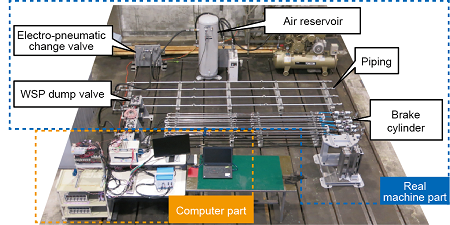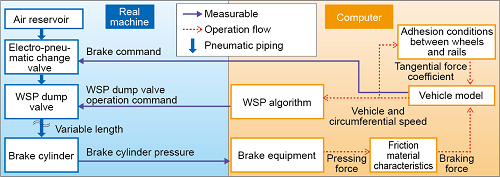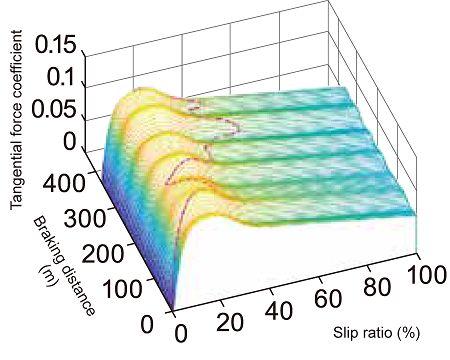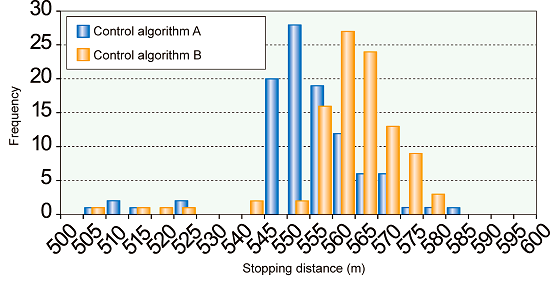25. Wheel slide protection simulator to supplement on-track testing
Adjustment of the control algorithm through on-track testing is the most important process in evaluating the performance of WSP under braking. However, it is not easy to stably reproduce the low adhesion conditions between wheels and rails in on-track testing, and the algorithm must be adjusted under different adhesion conditions for each run. To solve this problem, we have developed a WSP simulator that combines the advantages of real machine and computer.
The simulator consists of a real machine part that uses the same pneumatic system components as actual rail vehicles, from air reservoirs to brake cylinders, and a computer part that specifies the adhesion conditions, vehicle model, and WSP algorithm (Figs. 1 and 2). The real machine part uses variable length pneumatic piping to make the response of the pneumatic system variable. The computer part calculates the speed information (vehicle and circumferential speed) in real time based on the specified adhesion conditions (Fig. 3) and the vehicle model. This forms a real-time loop, that is, when the speed information satisfies the slide detection conditions of the WSP algorithm, the WSP dump value in the real machine part works to discharge the air in the brake cylinder, and the computer part reads the pressure change and calculates the speed information again.
With this simulator, various verifications can be performed by arbitrarily specifying the adhesion conditions and WSP algorithm, while reproducing the response characteristics using the pneumatic system of the actual rail vehicle. For example, by comparing the distribution of stopping distances for combinations of various adhesion conditions and WSP algorithms, the tendency of each WSP algorithm can be statistically evaluated (Fig. 4). Thus, by comparing the performance of promising WSP algorithms prior to the on-track testing, the number of test runs for the on-track testing can be halved.
Other Contents
- 22. Numerical simulation of ventilation in a vehicle by opening windows while running
- 23. Analytical evaluation method for the speed at which hunting occurs
- 24. Evaluation of the influence of wheel machining marks on the friction coefficient by visualizing the contact area
- 25. Wheel slide protection simulator to supplement on-track testing
- 26. Non-contact method to detect rail openings using aerial ultrasonic waves
- 27. Clarification of wear mechanism of current collecting materials caused by frictional heat
- 28. Method to evaluate physical properties of frictional materials by numerical simulation
- 29. Detection of changes in drivers' physical and mental state using physiological indicators
- 22. Numerical simulation of ventilation in a vehicle by opening windows while running
- 23. Analytical evaluation method for the speed at which hunting occurs
- 24. Evaluation of the influence of wheel machining marks on the friction coefficient by visualizing the contact area
- 25. Wheel slide protection simulator to supplement on-track testing
- 26. Non-contact method to detect rail openings using aerial ultrasonic waves
- 27. Clarification of wear mechanism of current collecting materials caused by frictional heat
- 28. Method to evaluate physical properties of frictional materials by numerical simulation
- 29. Detection of changes in drivers' physical and mental state using physiological indicators




